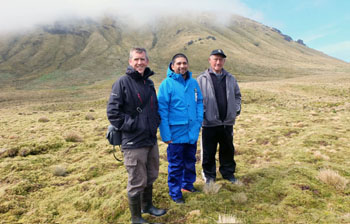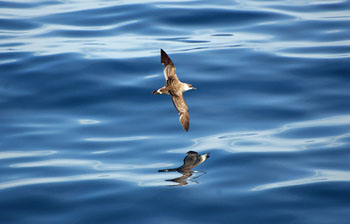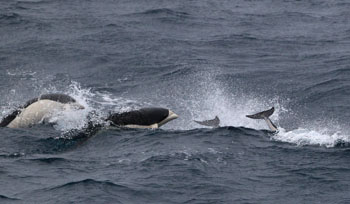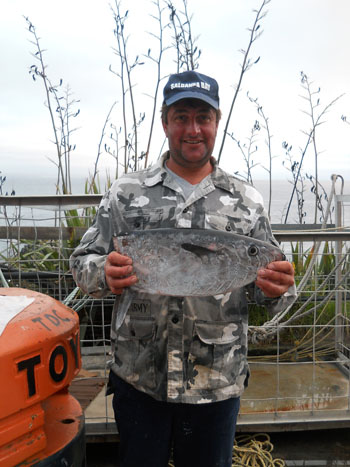|
Latest Wildlife News Harold Green returns to Gough Island after 60 yearssee 2015 Gough Island News
|
Great Shearwater Migrationsee- Great Shearwater page for more |
|
|
Southern Right Whale Dolphins in Tristan waterssee Whale News for more |
2015/16 Tristan Islands Conservation Work OverviewThe 2015 SA Agulhas II trip to Tristan and Gough Island provided the opportunity for a group of 16 conservation specialists to travel to the islands, joining the core SANAP 2015/16 team also aboard the ship. In addition two Tristan Islanders and Administrator Alex Mitham travelled to Gough Island to join and monitor the work underway. A RSPB contingent included UK Overseas Territories Officer Andy Schofield, who is in overall charge of the Tristan Islands’ RSPB project work and Senior Conservation Scientist Dr. Alex Bond, who co-ordinates the RSPB Tristan Islands’ field work. Andy travelled to Tristan and returned to Cape Town aboard the Agulhas in October, Alex travelled to Gough but returned to Tristan aboard the Agulhas in October where he will be based until he returns aboard MV Baltic Trader in December. Three research assistants employed by the Tristan Conservation Department and recruited by the RSPB travelled out to join the South African team based at Gough for the thirteen months 2015/16. Derren Fox and Chris Taylor from the UK, who will be involved with seabird monitoring, responsible for annual monitoring of breeding success, survival, population counts, and other field work for 14 breeding species on Gough throughout the year. Jan Bradley from South Africa will lead work to control the invasive plant, Sagina procumbens, including rope access to cliff sites where the alien plant has established. All three will be joining and living with the South African National Antarctic Programme (SANAP) over-wintering team, and will also be required to work within the requirements of SANAP’s team’s policies. Two more workers employed by the Tristan Conservation Department, Ben Dilley and Delia Davies, travelled to Tristan aboard the Agulhas to begin an eight month contract working with the Tristan da Cunha Conservation led by Trevor Glass and based on Tristan. They both joined other department members carrying out fieldwork on Nightingale Island in early November. Four conservation workers from South Africa aboard SA Agulhas II were focussed on seals on Gough Island: Greg Hofmeyr (Port Elizabeth Museum) and Maelle Connan (NMMU) were collecting seal skulls for stable isotope analysis and Nico de Bruyn and Chris Oosthuizen from University of Pretoria (UP) deployed devices on fur seals and elephant seals. Additionally Marthan Bester from UP stayed on Tristan to work with the Tristan Conservation deploying on fur seals at the Caves. As well as Alex Bond, other conservation experts aboard the Agulhas to Gough were Peter Ryan who is Director of the Percy FitzPatrick Institute of African Ornithology, University of Cape Town, Richard Phillips (British Antarctic Survey) to review seabird monitoring work, Mark Dagleish (from the Moredun Research Institute in Edinburgh), to look at health status of Gough land birds, and Carmen Ferreira for Sagina control, alongside Jan Bradley (see above). George Swain representing the Tristan Conservation Department, accompanied by Harold Green (see report below) also travelled to Gough, and were joined by Administrator Alex Mitham when he travelled to Gough aboard MV Edinburgh for the annual Tristan Government inspection of the South African Meteorological Station. Also aboard SA Agulhas was Katrine Herian who has previously worked on Tristan as a RSPB conservation officer but who has now begun a one-year contract with the Tristan Government as the 'Tristan da Cunha Policy Officer. Katrine travelled to Tristan in September, and in October returned to the UK, where she will work reviewing and updating Tristan’ da Cunha’s conservation legislation and policy. So in total, in addition to the core SANAP Gough Team, 16 conservation workers travelled to Tristan in 2015 aboard SA Agulhas II, with two further Tristan Islanders joining the ship for the Gough segment of the voyage, and Alex Mitham joining the Gough team aboard MV Edinburgh. We look forward to receiving reports and photographs of the on-going field work which we will report on the website and the newsletter to help celebrate conservation work on the Tristan da Cunha islands. |
Tristan Newsletter August 2015The August Tristan da Cunha Newsletter contains an article by Iain Orr reporting on Sir Martin Holdgate's 2015 Annual Gathering talk on the Global Importance of Tristan's wildlife. He makes references to the UNESCO World Heritage Site Gough and Inaccessible Islands Description and the United Nations Convention on Biological Diversity 5th Report. We have published the full UNESCO World Heritage Site Gough and Inaccessible Islands Description on a separate page: aiming to extend the website in due course to include similar Tristan data. |
Rare Sunfish discovered by Mark SwainPhotos from Marie Repetto |
|
|
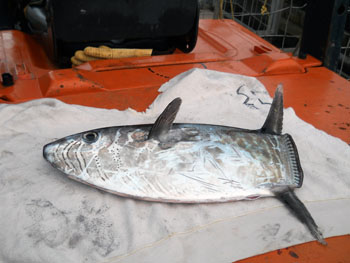 |
Mark Swain found a rare Slender Sunfish when walking a Tristan da Cunha beach on 21st March 2015. We have delayed publication to ascertain whether this is a new species record for Tristan. It does not appear in the definitive 'Field Guide to the animals and plants of Tristan da Cunha..' edited by Peter Ryan, but sunfish have been caught by fishermen around Tristan in the past. This could be the first example that has been photographed and recorded, but we await this confirmation. |
|
Slender Sunfish , Ranzania laevis : Background notes The Slender Sunfish occurs worldwide in most tropical and temperate marine waters. Sometimes referred to as a Slender Mola as it is of the family Molidae, the only member of the genus Ranzania. Unlike other molas, the slender mola never reaches more than a couple of feet in length. These are the most colourful and rarest of the ocean sunfishes. They have a smooth and thinner skin and a vertically oriented mouth. The Polynesians called these sunfish "King of the Mackerels". It was seen as bad luck to catch and kill Ranzania for such an act would render the mackerel incapable of finding their way to the islands. The Slender Sunfish has relatively slender oblong body, a pointed snout with a small funnel-like mouth, long pectoral fins, ‘smooth’ skin covered in tiny hexagonal scutes. Dark blue above, silvery on sides and below, with variable blue, grey, brown or green darkish stripes and spots; series of dark stripes curving below and behind eye to ventral surface. Off Australia they are rarely seen in coastal waters, large shoals occasionally strand themselves along Australia's south-west coast. |
|

